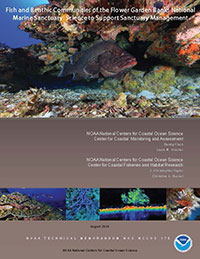-
Home
-
Data & Publications
-
Regional Portals
- About Regional Portals
- Florida
- Navassa Island
- Puerto Rico
- Flower Garden Banks
- U.S. Virgin Islands
- American Samoa
- Commonwealth of the Northern Mariana Islands
- Federated States of Micronesia
- Guam
- Main Hawaiian Islands
- Republic of the Marshall Islands
- Northwestern Hawaiian Islands
- Republic of Palau
- Pacific Remote Island Areas
-
CRCP Activities
- Glossary
Fish and Benthic Communities of the Flower Garden Banks National Marine Sanctuary: Science to Support Sanctuary Management

This report is the culmination of three years of fish and seafloor (benthic) invertebrate community observations on the East and West Flower Garden Banks. It provides baseline information on key biological communities, and can be utilized to address resource management priorities in Flower Garden Banks National Marine Sanctuary (FGBNMS). The benthic and fish community surveys were designed and implemented by a team of multi-disciplinary scientists using three complementary techniques:
- diver surveys, using recreational and technical scuba techniques, quantified benthic and fish communities on the coral reef at depths between 18-45 m/59-150 ft;
- remotely operated vehicles (ROV) conducted video surveys at depths greater than 46 m/150 ft; and
- fishery acoustics (sonar) surveyed fish in the water column across all habitat types and depths.
In April of 2012, NOAA published an updated management plan for the sanctuary, representing over five years of data analysis and public participation to ensure a sound strategy for conserving and protecting sanctuary resources for the future. During the management plan review process, input on potential resource protection and management issues was collected and summarized. This process identified direct and indirect impacts of fishing activities as a priority issue for management attention. Hook and line fishing (both commercial and recreational) has always been allowed within the sanctuary. However, to better understand this and other management issues, enhanced biogeographic data are needed to determine the most appropriate management actions needed to fulfill the sanctuary goals and objectives. The sanctuary Management Plan proposes a research strategy that includes characterizing FGBNMS to obtain comprehensive baseline information on fish and benthic communities prior to any management action. A second component of the strategy includes utilizing a fully-protected research area to compare to areas where fishing and other activities occur. The process of designing the research area will build upon prior successful efforts within other sanctuaries, such as Tortugas Ecological Reserve in Florida Keys National Marine Sanctuary and Gray's Reef National Marine Sanctuary, as well as the information presented in this report.
Citation: Clark, R., Kracker, L. M., Taylor, J. C., Buckel, C. A. (eds). August 2014. Fish and benthic communities of the Flower Garden Banks National Marine Sanctuary: Science to support sanctuary management. NOAA Technical Memorandum NOS NCCOS 179. Silver Spring, MD. 317 p.


